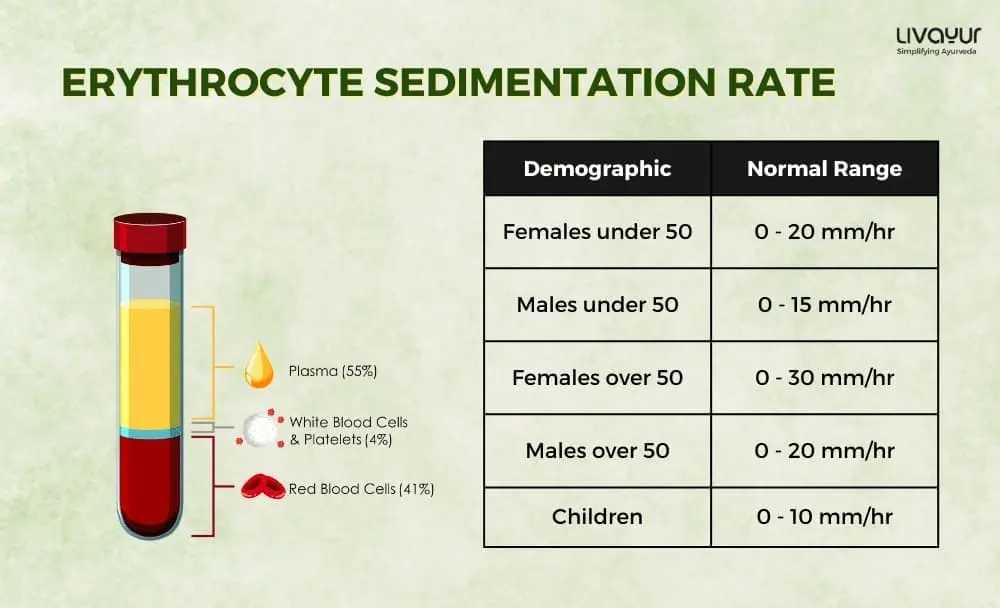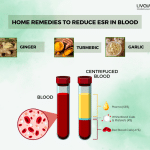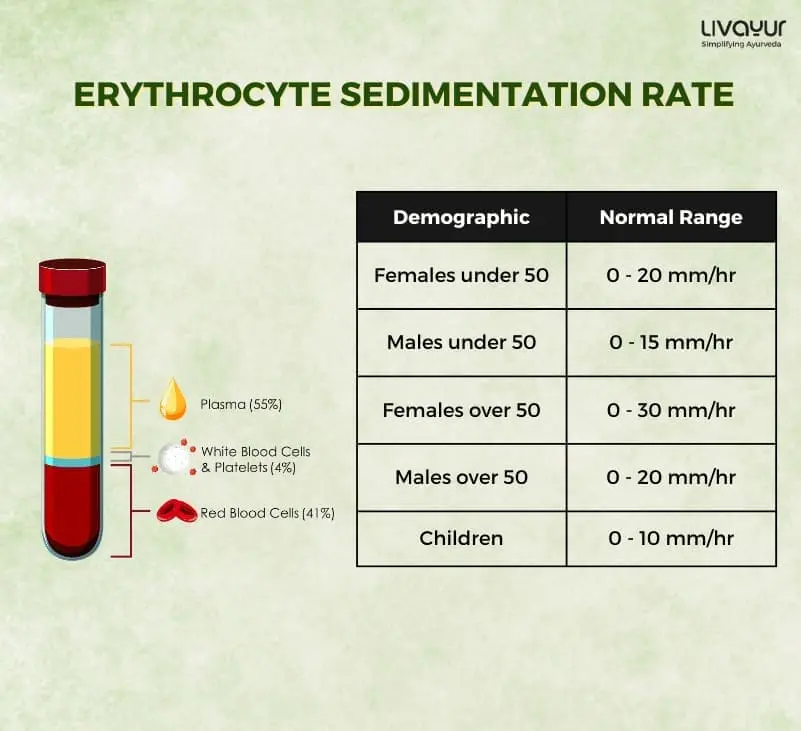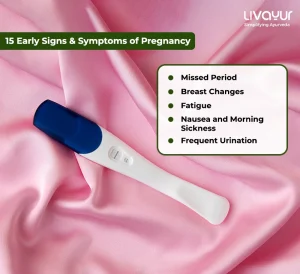
Do you know about the implications of high ESR levels in cancer patients? A routine hematology test called the erythrocyte sedimentation rate, or ESR for short, can detect and track an increase in inflammatory activity in the body. This inflammation can be caused by one or more illnesses such as infections, autoimmune diseases, or malignant tumors.
The ESR test will show you the rate of sedimentation of the Red blood cells, or erythrocytes as they sink to the bottom of a test tube containing blood. These cells may group due to inflammation in the body. The cell clusters tend to sink to the bottom faster because they are heavier than individual cells.
Your immune system will respond with increased inflammation the further the red blood cells have fallen to the bottom of the tube. [2] ESR test is a marker or indicator for several underlying health conditions, some of which may be as dangerous as cancer. This article will tell you ‘what is the ESR level in cancer patients’ and will also give you the details of the ESR test for cancer. Read on:
Understanding normal ESR test levels
Millimetres per hour (mm/hr) is used to measure the outcomes of ESR tests. There is a ber chance of inflammation the higher the number. ESR levels are generally higher in females. The results of a typical ESR test are as follows: [1]
| Group/Category | Normal ESR test results | Abnormal ESR test results |
| Females under 50 | between 0 and 20 mm/hr. | greater than 20 mm/hr. |
| Males under 50 | between 0 and 15 mm/hr. | greater than 15 mm/hr. |
| Females over 50 | between 0 and 30 mm/hr. | greater than 30 mm/hr. |
| Males over 50 | between 0 and 20 mm/hr. | greater than 20 mm/hr. |
| Children | between 0 and 10 mm/hr. | greater than 10 mm/hr. |
In conditions, such as cancer, diabetes, or cardiovascular disease, may be indicated by ESR test findings that are higher than 100 mm/hr.
Why is the ESR test done?
If you experience symptoms like unexplained fever, joint pain, or muscular aches, an ESR test may be prescribed. The test may support a diagnosis of the following conditions:
- Giant Cell Arteritis
- Polymyalgia Rheumatica
- Rheumatoid Arthritis
- Anemia
- Infections (including bone and joint)
- Systemic lupus erythematosus
- Systemic vasculitis
- Thyroid disease
Additionally, an ESR test can be used to assess the severity of your inflammatory response and the impact of treatment. An ESR test is frequently coupled with other blood tests, like the C-reactive protein (CRP) test, because it is unable to identify the issue that is producing inflammation in your body. [1]
About ESR level in cancer patients
Inflammation has long been recognized as vital, playing a crucial part in different processes connected to the advancement of cancer. Cancer has traditionally been thought of as a wound that does not heal. Immune cells, such as lymphocytes, neutrophils, and macrophages, are heavily infiltrated in the majority of tumors. As biological markers of DLBCL development, inflammation, and host immune response-related markers may be useful. [3]
There is a link between chronic inflammation and carcinogenesis. Also, subclinical or even undetectable inflammation may have a role in increased cancer risk, cancer development, and cancer progression on par with chronic inflammation.
Chronic inflammation may encourage excessive cell growth and trigger a series of biological events that support the development of tumor cells. Additionally, tumor growth itself may provoke an immunological reaction and inflammation in the host. [2]
How is ESR used to diagnose cancer?
High ESR levels could signal an underlying condition, potentially including cancer. Elevated levels often indicate inflammation within the body. In the context of cancer, this elevation serves as an important indicator, prompting a need for further investigation. [4]
In clinical use, including infectious, autoimmune, and malignant disorders, erythrocyte sedimentation rate (ESR) is the most often used laboratory test for assessing inflammatory conditions. Cancer patients typically have elevated ESR. The type of underlying ailment, the degree and length of the illness, the course and rigor of the anticancer therapy, and the result of diverse malignancies are all dependent on one another.
Additionally, a predictive marker that adversely affects cancer patients’ survival has been discovered as an elevated ESR level. Numerous studies revealed that a higher ESR level is linked to a worse prognosis; patients with higher ESR values in a variety of cancers, including colorectal cancer, renal cell cancer, head and neck cancer, soft tissue sarcoma, breast cancer, glioma, and prostate cancer, had a shorter prognosis compared to those with normal ESR levels.
The relationship between systemic inflammation and patient survival may have effects on how the immune system responds to melanoma. The relationship between inflammatory status and metastatic illness raises the possibility that metastatic melanoma may be more immunogenic, leading to a more pronounced inflammatory response.
ESR, a commonly used laboratory test for assessing the inflammatory status in clinical practice, was discovered to be bly linked with survival in melanoma patients, indicating a critical role for inflammation in the development of melanoma. It has been proposed that inflammatory cells may aid in the development of cancer by increasing DNA damage, encouraging the growth of tumor cells, and inducing angiogenesis and metastasis. [2]
Determinants affecting cancer patients’ ESR levels
The correlation between sex, histology, blood hemoglobin level, lactate dehydrogenase (LDH), and metastatic illness was found to be significant. Patients who have metastatic disease, low hemoglobin concentration, elevated LDH levels, and nodular histology are female patients.
ESR was also not related to lymph node involvement or chemotherapy responsiveness. ESR was found to be substantially correlated with outcome, nevertheless, and individuals with higher ESR values had poorer survival rates than those with normal values. Thus, it was discovered that high ESR was linked to metastatic disease and was also a predictive factor that hurt patients with cutaneous melanoma’s survival. [2]
What is the ESR test for cancer range?
A markedly high ESR value (>100 mm/hr) might suggest the existence of cancer.
Some tips to manage ESR levels
1. Consistent engagement in moderate to high levels of physical exercise helps manage ESR rates. [4]
2. Refrain from smoking as it is directly associated with higher ESR values. [5]
3. Keep alcohol consumption in moderation as studies have shown that ESR is increased in patients with complications of alcohol abuse and in those with alcoholic hepatitis. [5]
4. Keep your weight in check as being overweight, obesity, and metabolic syndrome are all positively associated with ESR in both males and females. [5]
FAQs
1. What is the significance of ESR (Erythrocyte Sedimentation Rate) levels in cancer patients?
ESR is a nonspecific marker of inflammation, and elevated levels in cancer patients may indicate the presence of inflammation associated with the cancer or its treatment. However, it’s essential to note that elevated ESR alone is not diagnostic of cancer and requires further investigation.
2. Can ESR levels be used to monitor the progress of cancer treatment?
ESR levels can be used as one of the indicators to monitor the response to cancer treatment. A decrease in ESR levels over time may suggest a positive response, while consistently high or rising levels might indicate ongoing inflammation or other underlying issues that need attention.
3. Are there conditions other than cancer that can cause elevated ESR levels in cancer patients?
Yes, various non-cancerous conditions can cause elevated ESR levels, including infections, autoimmune diseases, and certain inflammatory disorders. Differentiating between cancer-related and non-cancer-related causes of elevated ESR often requires a comprehensive evaluation by healthcare professionals
4. What is the implication of ESR 48?
ESR 48 stands for active sickness which should not be ignored.
Conclusion
In conclusion, the erythrocyte sedimentation rate (ESR) is an important marker of inflammatory activity that is essential for making a variety of diagnoses. Particularly, high ESR levels in cancer patients provide prognostic information as well as indicate the existence of malignancy. The significance of ESR as a predictive marker is highlighted by the association between chronic inflammation and malignancy.
Studies on a variety of malignancies frequently show a link between worse prognoses and elevated ESR readings. ESR is a common yet effective diagnostic test that not only assists in identifying diseases but also emphasizes their influence on the clinical trajectory, highlighting the crucial interaction between inflammation and cancer growth.
Disclaimer
This article is written from a health and lifestyle perspective. It is for general information and is not meant to substitute any medical advice. Please consult your doctor for appropriate medical consultation.
References:
- Erythrocyte Sedimentation Rate
- Elevated erythrocyte sedimentation rate is associated with metastatic disease and worse survival in patients with cutaneous malignant melanoma
- Inflammation marker ESR is effective in predicting outcome of diffuse large B-cell lymphoma
- Erythrocyte Sedimentation Rate
- Factors influencing erythrocyte sedimentation rate in adults






















1 Comments